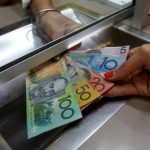
Focus now turns to key upcoming economic readings from China, as well as a Reserve Bank of Australia meeting this week for more cues on major Asian economies.
Sentiment was largely risk-on after data on Friday showed that U.S. nonfarm payrolls grew less than expected in October. The reading signaled more cooling in the U.S. labor market, which has been a key driver of the Fed’s hawkish stance this year.
This drove traders into more risk-heavy Asian markets, with the South Korean won and the Thai baht adding 0.5% and 0.2%, respectively.
Southeast Asian currencies saw the biggest gains for the day, with the Malaysian ringgit up 1.2%.
The Japanese yen fell 0.2%, steadying below the 150 level against the dollar. Data on Monday showed that Japan’s services sector grew more than expected in October.
But the outlook for the yen remained weak following dovish signals from the Bank of Japan.
Governor Kazuo Ueda furthered this notion on Monday, stating that while progress was being made towards reaching the bank’s 2% inflation target, it was still insufficient to justify a pivot away from the BOJ’s ultra-loose policy.
A dovish BOJ has been the key source of pressure on the yen this year, which was trading close to levels last seen in 1990, during the onset of Japan’s lost decade.
The dollar index and dollar index futures both rose slightly in Asian trade after sinking to their lowest levels since late-September on Friday.
U.S. Treasury yields also retreated, as traders priced in a 95.2% chance that the Fed will not hike rates any further this year. There also stands an over 80% chance that the Fed will begin trimming rates by June 2024.
But while the prospect of no more hikes bodes well for Asian markets, the central bank is still expected to keep rates higher for longer, denting the chances of any major near-term gains in Asian currencies.
The Chinese yuan rose 0.2% on Monday, benefiting from a weaker dollar and a stronger daily midpoint fix by the People’s Bank of China.
Focus is now squarely on trade and inflation data due this week, which is expected to shed more light on a sluggish economic recovery in the country.
The data also comes just a week after a slew of official and private readings showed further deteriorating in Chinese business activity- a trend that further damaged investor sentiment towards Chinese markets.
The Australian dollar rose slightly on Monday, but traded close to a two-month high as markets priced in a 25 basis point hike by the RBA on Tuesday.
The move is widely expected by markets following a recent uptick in Australian consumer inflation. Other data also showed that retail sales unexpectedly grew in the third quarter, underpinning expectations of sticky inflation.
While the RBA has kept rates on hold since May, it has still left the door open to more rate hikes, especially if inflation remained sticky. The bank had hiked rates by a cumulative 400 bps since early-2022.
To read the full article, Click Here

